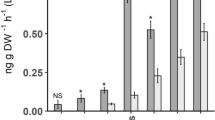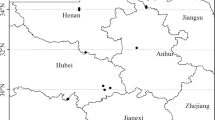Abstract
Increasing our understanding of spatial patterns of plant secondary chemistry variation may help us understand the mechanisms that underlie plant invasions involving species which exhibit chemical phenotypic variation. We analysed qualitative and quantitative variation in the essential oil terpenes produced by Thymus vulgaris L. (thyme) plants inside and at the edge of thyme-invaded plant communities on north- and south-facing slopes at ten sites across Central Otago, New Zealand. We tested the hypotheses that (1) there are foliar terpene composition quantitative and qualitative differences between the inside and edge of thyme-invaded communities and that these differences vary between north- and south-facing slopes and (2) that environmental variables affect the quantity and quality of thyme essential oil composition. Terpene concentrations were determined using ethanol extraction and GC FID/MS. Environmental data were collected from inside, at the edge and outside of thyme stands. We used multivariate statistical analysis to test differences in foliar terpene composition and linear modelling to investigate the effects of environmental variables on terpene composition. We found no evidence of a link between aspect- and invasion edge-related patterns of variation of thyme’s essential oil chemistry. Site-related differences for aspect and position in thyme stands indicated that thyme’s terpene production may be modulated by environmental factors such as soil moisture, clay, carbon, silt, sand, colloid, N and NH4 +. The role of thyme’s novel chemistry in the processes that underlie the spatial patterns of thyme’s successful invasion is modulated by environmental factors.



Similar content being viewed by others
References
Adams RP (2007) Identification of essential oil components by Gas Chromatography/Mass Spectroscopy. Allured Publishing Corp, Carol Stream
Allen SE, Grimshaw HM, Parkinson JA, Quarmby C (1986) Chemical analysis of ecological materials. Blackwell Scientific, Oxford
Amiot J, Salmon Y, Collin C, Thompson JD, Waller D (2005) Differential resistance to freezing and spatial distribution in a chemically polymorphic plant Thymus vulgaris. Ecol Lett 8:370–377
Anderson MJ (2001) A new method for non-parametric multivariate analysis of variance. Aust Ecol 26:32–46
Anderson MJ (2002) DISTLM v.2: A Fortran computer program to calculate distance-based multivariate analysis for a linear model. Information Sheet, Department of Statistics, University of Auckland, Auckland, New Zealand
Ates E (2011) Some chemical and morphological properties of five clover species (Trifolium sp.) at different aspect of pasture in Belovets village (Razgrad), Bulgaria. Int J Plant Prod 5:255–262
Barney JN, Whitlow TH, Ditommaso A (2009) Evolution of an invasive phenotype: shift to belowground dominance and enhanced competitive ability in the introduced range. Plant Ecol 202:275–284
Blair AC, Wolfe LM (2004) The evolution of an invasive plant: an experimental study with Silene latifolia. Ecology 85:3035–3042
Blakemore LC, Searle PL, Daly BK (1987) Methods for chemical analysis of soils. NZ Soil Bureau Scientific Report 80
Blossey B, Nötzold R (1995) Evolution of increased competitive ability in invasive nonindigenous plants: a Hypothesis. J Ecol 83:887–889
Boira H, Blanquer A (1998) Environmental factors affecting chemical variability of essential oils in Thymus piperella L. Biochem Syst Ecol 26:811–822
Brenes-Arguedas T, Coley PD (2005) Phenotypic variation and spatial structure of secondary chemistry in a natural population of a tropical tree species. Oikos 108:410–420
Brothers TS, Spingarn A (1992) Forest fragmentation and alien plant invasion of Central Indiana old-growth forests. Conserv Biol 6:91–100
Cadenasso ML, Traynor MM, Pickett STA (1997) Functional location of forest edges: gradients of multiple physical factors. Can J Forest Res 27:774–782
Callaway R, Aschehoug ET (2000) Invasive plants versus their new and old neighbors: a mechanism for exotic invasion. Science 290:521–523
Callaway RM, Ridenour WM (2004) Novel weapons: invasive success and the evolution of increased competitive ability. Front Ecol Environ 2:436–443
Callaway RM, Cipollini D, Barto K, Thele GC, Hallett SG, Prati D, Stinson K, Klironomos J (2008) Novel weapons: invasive plant suppresses fungal mutualists in America but not in its native Europe. Ecology 89:1043–1055
Cappuccino N, Arnason JT (2006) Novel chemistry of invasive exotic plants. Biol Lett 2:189–193
Cockayne L (1928) The vegetation of New Zealand. W. Engelmann, Leipzig
Darwin C (1859) On the origin of species by means of natural selection, or the preservation of favoured races in the struggle for life. John Murray, London
Ehlers B, Thompson J (2004) Do co-occurring plant species adapt to one another? The response of Bromus eretus to the presence of different Thymus vulgaris chemotypes. Oecologia 141:511–518
Ehrenfeld JG (2006) A potential novel source of information for screening and monitoring the impact of exotic plants on ecosystems. Biol Invasion 8:1511–1521
Elton CS (1958) The ecology of invasions by animals and plants. Methuen and Co., London
Fan L, Chen Y, Yuan J, Yang Z (2010) The effect of Lantana camara Linn. invasion on soil chemical and microbiological properties and plant biomass accumulation in southern China. Geoderma 154:370–378
Forman RTT (1995) Some general principles of landscape and regional ecology. Landsc Ecol 10:133–142
FOSS (2000a) Determination of ammonium in 2 m KCI soil extracts by FIAStar 5000 Foss Tecator AB2000 AN 5226
FOSS (2000b) FIAStar 5012 system Tecator Application Note ASN 62-02/83; and ASN 110-01/92 and ASN 65-31/84
Gomulkiewicz R, Thompson JN, Holt RD, Nuismer SL, Hochberg ME (2000) Hot spots, cold spots, and the geographic mosaic theory of coevolution. Am Nat 156:156–174
Gouyon P, Vernet P, Guillerm J, Valdeyron G (1986) Polymorphisms and environment: the adaptive value of the oil polymorphisms in Thymus vulgaris L. Heredity 57:59–66
Johnson CB, Kazantzis A, Skoula M, Mitteregger U, Novak J (2004) Seasonal, populational and ontogenic variation in the volatile oil content and composition of individuals of Origanum vulgare subsp. Hirtum, assessed by GC headspace analysis and by SPME sampling of individual oil glands. Phytochem Anal 15:286–292
Keefover-Ring K (2008) One chemistry, two continents: Function and maintenance of chemical polymorphism in the mint family (Lamiaceae). Ph.D. 3303896, University of Colorado at Boulder, United States – Colorado. Retrieved from http://proquest.umi.com/pqdweb?did=1507551951andFmt=7andclientId=18927andRQT=309andVName=PQD
Keefover-Ring K (2013) Making scents of defense: do fecal shields and herbivore-caused volatiles match host plant chemical profiles? Chemoecology 23:1–11
Keefover-Ring K, Thompson JD, Linhart YB (2009) Beyond six scents: defining a seventh Thymus vulgaris chemotype new to southern France by ethanol extraction. Flavour Frag J 24:117–122
Letchamo W, Gosselin A (1995) Effects of HPS supplemental lighting and soil water levels on growth, essential oil content and composition of two thyme (Thymus vulgaris L) clonal selections. Can J Plant Sci 75:231–238
Linhart YB, Thompson JD (1995) Terpene-based selective herbivory by Helix aspersa (Mollusca) on Thymus vulgaris (Labiatae). Oecologia 102:126–132
Linhart YB, Thompson JD (1999) Thyme is of the essence: biochemical polymorphism and multi-species deterrence. Evol Ecol Res 1:151–171
Linhart YB, Keefover-Ring K, Mooney KA, Breland B, Thompson JD (2005) A chemical polymorphism in a multitrophic setting: thyme monoterpene composition and food web structure. Am Nat 166:517–529
Mack RN, Simberloff D, Lonsdale WM, Evans H, Clout M, Bazzaz FA (2000) Biotic invasions: causes, epidemiology, global consequences, and control. Ecol Appl 10:689–710
McArdle BH, Anderson MJ (2001) Fitting multivariate models to community data: a comment on distance based redundancy analysis. Ecology 82:290–297
McGimpsey JA, Douglas MH, Van Klink JW, Beauregard DA, Perry NB (1994) Seasonal variation in essential oil yield and composition from naturalized Thymus vulgaris L. in New Zealand. Flavour Frag J 9:347–352
Metservice.com (2012) Climate Summary 1969–1988. Retrieved 30 June 2012
Metson AJ (1956) Methods of chemical analysis for soil survey samples. NZ Soil Bur Bull 12:168–171
Moles AT, Gruber MAM, Bonser SP (2008) A new framework for predicting invasive plant species. J Ecol 96:13–17
Morgan RK (1989) Chemotypic characteristics of Thymus vulgaris L. in Central Otago, New Zealand. J Biogeogr 16:483–491
Murcia C (1995) Edge effects in fragmented forests: implications for conservation. Trends Ecol Evol 10:58–62
Paavolainen L, Kitunen V, Smolander A (1998) Inhibition of nitrification in forest soil by monoterpenes. Plant Soil 205:147–154
Pimentel D, Lach L, Zuniga R, Morrison D (2000) Environmental and economic costs of nonindigenous species in the United States. Bioscience 50:53–65
Poulose AJ, Croteau R (1978) Biosynthesis of aromatic monoterpenes: conversion of γ-terpinene to p-cymene and thymol in Thymus vulgaris L. Arch Biochem Biophys 187:307–314
Richardson DM, Pyšek P, Rejmánek M, Barbour MG, Panetta FD, West CJ (2000) Naturalization and invasion of alien plants: concepts and definitions. Divers Distrib 6:93–107
Rowell DL (1994) Soil science, methods and applications. Longman Scientific and Technical, London
Schaffner U, Ridenour WM, Wolf VC, Bassett T, Muller C, Muller-Scharer H, Sutherland S, Lortie CJ, Callaway RM (2011) Plant invasions, generalist herbivores, and novel defense weapons. Ecology 92:829–835
Tanaka S, Yamaura T, Shigemoto R, Tabata M (1989) Phytochrome-mediated production of monoterpenes in thyme seedlings. Phytochemistry 28:2955–2957
Tarayre M, Thompson JD, Escarre J, Linhart YB (1995) Intra-specific variation in the inhibitory effects of Thymus vulgaris Labiatae monoterpenes on seed germination. Oecologia 10:110–118
Thompson JD (2002) Population structure and the spatial dynamics of genetic polymorphisms in thyme. In: Stahl-Biskup E, Saez F (eds) Thyme: The Genus Thymus. Taylor and Francis, London, pp 44–74
Thompson JD (2005) Plant evolution in the Mediterranean. University of Oxford Press, Oxford
Thompson JD, Manicacci D, Tarayre M (1998) Thirty-five years of thyme: a tale of two polymorphisms. Why so many females? Why so many chemotypes? Bioscience 48:805–815
Thompson JD, Chalchat JC, Michet A, Ehlers B, Linhart YB (2003) Qualitative and quantitative variation in monoterpene co-occurrence and composition in the essential oil of Thymus vulgaris chemotypes. J Chem Ecol 29:859–880
Thompson JD, Gauthier P, Amiot J, Ehlers BK, Collin C, Fossat J, Barrios V, Arnaud-Miramont F, Keefover-Ring KEN, Linhart YB (2007) Ongoing adaptation to Mediterranean climate extremes in a chemically polymorphic plant. Ecol Monogr 77:421–439
Thomson GM (1922) The naturalization of animals and plants in New Zealand. Cambridge University Press, Cambridge
Vernet P, Gouyon R, Valdeyron G (1986) Genetic control of the oil content in Thymus vulgaris L: a case of polymorphism in a biosynthetic chain. Genetica 69:227–231
Vitousek PM, D’Antonio CM, Loope LL, Westbrooks R (1996) Biological invasions as global environmental change. Am Sci 84:468–468
Vokou D, Kokkin S, Bessiere J-M (1993) Geographic variation of Greek oregano (Origanum vulgare ssp. hirtum) essential oils. Biochem Syst Ecol 21:287–295
Weidenhamer JD, Macias FA, Fisher NH, Williamson GB (1993) Just how insoluble are monoterpenes. J Chem Ecol 19:1799–1807
White C (1986) Volatile and water-soluble inhibitors of nitrogen mineralization and nitrification in a Ponderosa pine ecosystem. Biol Fertil Soils 2:97–104
White C (1994) Monoterpenes—their effects on ecosystem nutrient cycling. J Chem Ecol 20:1381–1406
Wilkinson EL, Dann GM, Smith GJS (1979) Thyme in Central Otago. BulletinTussock Grasslands and Mountain Lands Institute, Lincoln College, Christchurch
Wolf JJ, Beatty SW, Carey G (2003) Invasion by Sweet Clover (Melilotus) in Montane Grasslands, Rocky Mountain National Park. Ann Assoc Am Geogr 93:531–543
Yamaura T, Tanaka S, Tabata M (1991) Participation of phytochrome in the photoregulation of terpenoid synthesis in thyme seedlings. Plant Cell Physiol 32:603–607
Yamaura T, Tanaka S, Tabata M (1992) Localization of the biosynthesis and accumulation of monoterpenoids in glandular trichomes of thyme. Planta Med 58:153–158
Acknowledgments
This research was funded by the Miss E.L. Hellaby Indigenous Grasslands Research Trust. We thank the Snow family for their assistance in the field and the Central Otago landowners and businesses who gave permission to carry out research on their land: Sam Leask, Chard Farm Winery, AJ Hackett Bungy New Zealand. We also thank Dr Nigel Perry, Dr Kenneth Keefover-Ring and Catherine Sansom for technical advice and suggestions.
Author information
Authors and Affiliations
Corresponding author
Additional information
Handling Editor: Kerstin Reifenrath.
Electronic supplementary material:
Below is the link to the electronic supplementary material.
Rights and permissions
About this article
Cite this article
Nielsen, J.A., Whigham, P.A., Frew, R.D. et al. Invasion essentials: does secondary chemistry plasticity contribute to the invasiveness of Thymus vulgaris L.?. Chemoecology 24, 15–27 (2014). https://doi.org/10.1007/s00049-013-0142-1
Received:
Accepted:
Published:
Issue Date:
DOI: https://doi.org/10.1007/s00049-013-0142-1




